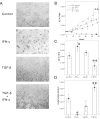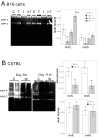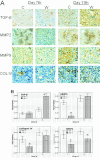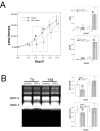A pilot study on acute inflammation and cancer: a new balance between IFN-gamma and TGF-beta in melanoma
- PMID: 19228418
- PMCID: PMC2683570
- DOI: 10.1186/1756-9966-28-23
A pilot study on acute inflammation and cancer: a new balance between IFN-gamma and TGF-beta in melanoma
Abstract
Recent data have redefined the concept of inflammation as a critical component of tumor progression. However, there has been little development on cases where inflammation on or near a wound and a tumor exist simultaneously. Therefore, this pilot study aims to observe the impact of a wound on a tumor, to build a new mouse tumor model with a manufactured surgical wound representing acute inflammation, and to evaluate the relationship between acute inflammation or wound healing and the process of tumor growth. We focus on the two phases that are present when acute inflammation influences tumor. In the early phase, inhibitory effects are present. The process that produces these effects is the functional reaction of IFN-gamma secretions from a wound inflammation. In the latter phase, the inhibited tumor is made resistant to IFN-gamma through the release of TGF-beta to balance the inflammatory factor effect on the tumor cells. A pair of cytokines IFN-gamma/TGF-beta established a new balance to protect the tumor from the interference effect of the inflammation. The tumor was made resistant to IFN-gamma through the release of TGF-beta to balance the inflammatory effect on the tumor cells. This balance mechanism that occurred in the tumor cells increased proliferation and invasion. In vitro and in vivo experiments have confirmed a new view of clinical surgery that will provide more detailed information on the evaluation of tumors after surgery. This study also provides a better understanding of the relationship between tumor and inflammation, as well as tumor cell attacks on inflammatory factors.
Figures






References
-
- Balkwill F, Mantovani A. Inflammation and cancer: back to Virchow? Lancet. 2001;357:539–545. - PubMed
-
- Aggarwal BB, Shishodia S, Sandur SK, Pandey MK, Sethi G. Inflammation and cancer: how hot is the link? Biochem Pharmacol. 2006;72:1605–1621. - PubMed
-
- Chettibi S, Ferguson MW. In: Inflammation: Basic Principles and Clinical Correlates. Gallin JI, Snyderman R, editor. Williams and Wilkinson. Lipincott. Philadelphia; 1999. pp. 865–881.
-
- Brigati C, Noonan DM, Albini A, Benelli R. Tumors and inflammatory infiltrates: friends or foes? Clin Exp Metastasis. 2002;19:247–258. - PubMed
Publication types
MeSH terms
Substances
LinkOut - more resources
Full Text Sources
Medical

